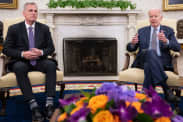The U.S. dollar has defied the threat of a historic U.S. debt default and climbed in recent weeks at the most rapid pace since February.
Even though the debt-ceiling impasse in Washington has helped revive talk of de-dollarization, Wall Street analysts say there is good reason for the dollar’s resilience these past few weeks.
In fact, some expect the greenback could trade sharply higher, potentially even surpassing the multidecade highs reached last September, if a historic U.S. default becomes a reality.
As talks between U.S. House Speaker Kevin McCarthy and President Joe Biden hit another snag on Wednesday, the ICE U.S. Dollar Index
DXY,
The notion that the dollar might benefit from a default, at least in the short term, might sound counterintuitive, but the dollar’s status as a popular safety play for investors around the world means it has historically thrived in the midst of chaos.
“I think it’s a very nonlinear type of dynamic that, if push came to shove and the U.S. was going to default, it would become dollar positive very quickly,” said Steve Englander, head of North American macro strategy at Standard Chartered, during an interview with MarketWatch.
Many on Wall Street see an agreement in Congress to avoid default as a foregone conclusion eventually, but Englander said Republicans’ skepticism about the timing of the “X date” could throw a wrench in the works, making a default more likely.
Of course, the dollar would still likely sustain reputational damage if default becomes a reality, Englander said, but this would have little bearing on the immediate reaction, which would resemble a knee-jerk move higher.
During the financial crisis, the dollar strengthened by 20% between July 2008 and March 2009, according to FactSet data, defying concerns about the failure of several banks.
A rise of a similar magnitude in the months ahead would see the dollar rise to its highest level since the early 2000s, but over the long term the impact would likely be more mixed.
“It is a complicated dynamic, and it’s dollar negative in the long term due to loss of confidence,” Englander said.
“But in the short term, we live in a dollar-based world, so if something happens that is enormously risk off, you’re going to try to get as much dollar-denominated cash as you can.”
Currency analysts have cited several reasons for the dollar’s gains over the past two weeks in addition to the risk-off flows spurred by the debt-ceiling standoff in Washington.
One of the most popular reasons has been the recent rise in yields of longer-dated Treasurys.
The yield on the 10-year Treasury note
TMUBMUSD10Y,
Instead of focusing on the debt-ceiling talks, traders are instead focusing on comments from Federal Reserve policy makers such as Dallas Fed President Lorie Logan, who said earlier in May that the Fed should continue hiking interest rates.
“The dollar has continued to build bullish momentum, drawing strength from the repricing in Federal Reserve rate expectations,” said Francesco Pesole, a currency strategist at ING, in commentary emailed to clients.
Expectations for a flood of Treasury bill issuance in the months ahead after the debt ceiling is lifted have also benefited the dollar, said Bipan Rai, head of currency strategy at CIBC Capital Markets, in an interview with MarketWatch.
Once Congress reaches a deal to raise the debt ceiling, the Treasury will need to replenish its reserves. It is expected to do this by first issuing debt that will mature in the coming weeks and months.
“We’re going to see a swell of issuance from the Treasury, and that is going to be supportive for the dollar,” he said.
A team of bond-market analysts at Bank of America expect the deluge of new bills through August to be about five times the supply of an average three-month stretch during the years before the pandemic.
See: A debt-ceiling deal will spark a new worry: Who will buy the deluge of Treasury bills?
Looking ahead, currency traders will be watching to see if the dollar manages to surpass the 105.40 level on the index
DXY,







